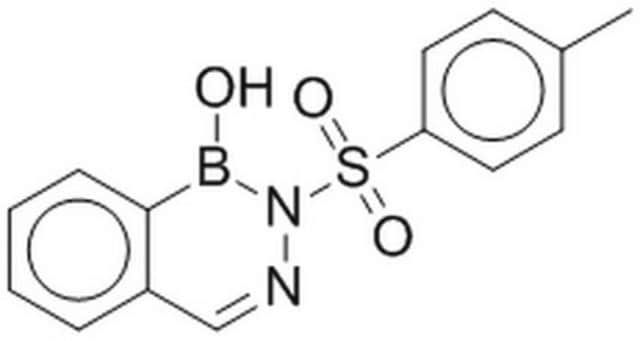P0025
Platensimycin
≥90% (HPLC), from Streptomyces platensis
About This Item
Productos recomendados
origen biológico
Streptomyces platensis
Ensayo
≥90% (HPLC)
Formulario
solid
color
white to beige
solubilidad
DMSO: 1 mg/mL, clear, colorless
espectro de actividad antibiótica
Gram-negative bacteria
Gram-positive bacteria
Modo de acción
enzyme | inhibits
temp. de almacenamiento
−20°C
cadena SMILES
O=C1C=C[C@]2(C[H])[C@H]3CC[C@@](O3)([H])C2C1CCC(CNC4=C(O)C=CC(C(O)=O)=C4O)=O
InChI
1S/C22H25NO7/c1-22-9-8-14(25)12(18(22)16-6-7-17(22)30-16)3-2-11(24)10-23-19-15(26)5-4-13(20(19)27)21(28)29/h4-5,8-9,12,16-18,23,26-27H,2-3,6-7,10H2,1H3,(H,28,29)/t12?,16-,17+,18?,22+/m0/s1
Clave InChI
IGBNLKVUOHQLTO-MBQNLBDGSA-N
Aplicación
Acciones bioquímicas o fisiológicas
Mode of action: Selectively inhibits lipid biosynthesis by targeting FabF/B within the fatty acid synthesis pathway.
Antimicrobial spectrum: Gram-positive bacteria.
Otras notas
Código de clase de almacenamiento
11 - Combustible Solids
Clase de riesgo para el agua (WGK)
WGK 3
Punto de inflamabilidad (°F)
Not applicable
Punto de inflamabilidad (°C)
Not applicable
Elija entre una de las versiones más recientes:
Certificados de análisis (COA)
¿No ve la versión correcta?
Si necesita una versión concreta, puede buscar un certificado específico por el número de lote.
¿Ya tiene este producto?
Encuentre la documentación para los productos que ha comprado recientemente en la Biblioteca de documentos.
Active Filters
Nuestro equipo de científicos tiene experiencia en todas las áreas de investigación: Ciencias de la vida, Ciencia de los materiales, Síntesis química, Cromatografía, Analítica y muchas otras.
Póngase en contacto con el Servicio técnico




![Adenosine 5′-[γ-thio]triphosphate tetralithium salt ≥75% (HPLC), powder](/deepweb/assets/sigmaaldrich/product/structures/319/398/e29221c2-3649-455b-bd33-583bb017ec7d/640/e29221c2-3649-455b-bd33-583bb017ec7d.png)



